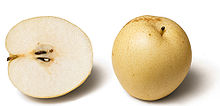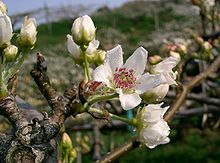Pyrus pyrifolia: Difference between revisions
Undid revision 706590891 by Azsunflour (talk) inappropriate "citation" |
Cyberbot II (talk | contribs) Rescuing 1 sources. #IABot |
||
| Line 57: | Line 57: | ||
| url=http://www.asiafood.org/glossary_2.cfm?word=nashi&wordid=2785 |
| url=http://www.asiafood.org/glossary_2.cfm?word=nashi&wordid=2785 |
||
| accessdate=2008-07-11 |
| accessdate=2008-07-11 |
||
}}{{ |
}} {{wayback|url=http://www.asiafood.org/glossary_2.cfm?word=nashi&wordid=2785 |date=20090521123106 }}</ref> The fruit tends to be quite large and fragrant, and when carefully wrapped (it has a tendency to bruise because of its juiciness), it can last for several weeks or more in a cold, dry place. |
||
== Culture == |
== Culture == |
||
Revision as of 13:17, 28 February 2016
| Pyrus pyrifolia | |
|---|---|

| |
| Scientific classification | |
| Kingdom: | |
| (unranked): | |
| (unranked): | |
| (unranked): | |
| Order: | |
| Family: | |
| Genus: | |
| Species: | P. pyrifolia
|
| Binomial name | |
| Pyrus pyrifolia | |
 | |||||||||||||||||||||||||||||||||||||||||||||
| Nutritional value per 100 g (3.5 oz) | |||||||||||||||||||||||||||||||||||||||||||||
|---|---|---|---|---|---|---|---|---|---|---|---|---|---|---|---|---|---|---|---|---|---|---|---|---|---|---|---|---|---|---|---|---|---|---|---|---|---|---|---|---|---|---|---|---|---|
| Energy | 176 kJ (42 kcal) | ||||||||||||||||||||||||||||||||||||||||||||
10.65 g | |||||||||||||||||||||||||||||||||||||||||||||
| Sugars | 7.05 g | ||||||||||||||||||||||||||||||||||||||||||||
| Dietary fiber | 3.6 g | ||||||||||||||||||||||||||||||||||||||||||||
0.23 g | |||||||||||||||||||||||||||||||||||||||||||||
0.5 g | |||||||||||||||||||||||||||||||||||||||||||||
| |||||||||||||||||||||||||||||||||||||||||||||
| †Percentages estimated using US recommendations for adults,[1] except for potassium, which is estimated based on expert recommendation from the National Academies.[2] | |||||||||||||||||||||||||||||||||||||||||||||
Pyrus pyrifolia is a species of pear tree native to East Asia.
The tree's edible fruit is known by many names, including: Asian pear,[3] Chinese pear,[3][4] Korean pear, Japanese pear,[3] Japanese Apple Pear, Taiwanese pear, and sand pear.[3] Along with cultivars of P. × bretschneideri and P. ussuriensis, the fruit is also called the nashi pear.[5][6] Cultivars derived from Pyrus pyrifolia are grown throughout East Asia, and in other countries such as Australia, New Zealand, and the United States (e.g., California). Traditionally in East Asia the tree's flowers are a popular symbol of early spring, and it is a common sight in gardens and the countryside.
The fruits are not generally baked in pies or made into jams because they have a high water content and a crisp, grainy texture, very different from the European varieties. They are commonly served raw and peeled.[7] The fruit tends to be quite large and fragrant, and when carefully wrapped (it has a tendency to bruise because of its juiciness), it can last for several weeks or more in a cold, dry place.
Culture

Due to their relatively high price and the large size of the fruit of cultivars, the pears tend to be served to guests, given as gifts, or eaten together in a family setting.
In cooking, ground pears are used in vinegar- or soy sauce-based sauces as a sweetener, instead of sugar. They are also used when marinating meat, especially beef.
In Korea, the fruit is known as bae (배), and it is grown and consumed in great quantity. In the South Korean city of Naju, there is a museum called The Naju Pear Museum and Pear Orchard for Tourists (나주 배 박물관 및 배밭 관광체험).
In Australia, these pears have been commercially produced for more than 25 years.[8]
In Japan, fruit is harvested in Chiba, Ibaraki, Tottori, Fukushima, Tochigi, Nagano, Niigata, Saitama and other prefectures, except Okinawa. Nashi (ja:梨) may be used as a late Autumn kigo, or “season word”, when writing haiku. Nashi no hana (ja:梨の花, pear flower) is also used as a kigo of spring.[9] At least one city (Kamagaya-Shi, Chiba Prefecture) has the flowers of this tree as an official city flower.
In Nepal and the Himalayan states of India, they are called nashpati and are cultivated as a cash crop in the Middle Hills between about 1,500 and 2,500 meters’ elevation where the climate is suitable. The fruit are carried to nearby markets by human porters or, increasingly, by truck, but not for long distances because they bruise easily.
In Taiwan, pears harvested in Japan have become luxurious presents since 1997 and their consumption has jumped.[citation needed]
In China, it is considered a social faux pas to share a pear with a friend or loved one. "Sharing a pear" (分梨) is a homophone of "separate" (分离).[10]
In Cyprus, the pears were introduced in 2010 after initially being investigated as a new fruit crop for the island in the early 1990s. They are currently grown in Kyperounta.[11]
Cultivars
Cultivars are classified in two groups. Most of the cultivars belong to the Akanashi ('Russet pears') group, and have yellowish-brown rinds. The Aonashi ('Green pears') have yellow-green rinds.
Important cultivars include:
- 'Chojuro' (ja:長十郎, Japan, 1893?)[12][13] ('Russet pears')
- 'Kosui' (ja:幸水, Japan, 1959; the most important cultivar in Japan),[14][15] ('Russet pears')
- 'Hosui' (ja:豊水, Japan, 1972)[16][17] ('Russet pears')
- 'Imamuraaki' (ja:今村秋, Japan, native)[18] ('Russet pears')
- 'Nijisseiki' (ja:二十世紀, Japan, 1898; name means "20th century", also spelled 'Nijusseiki')[19][20] ('Green pears')
- 'Niitaka' (ja:新高, Japan, 1927)[21][22] ('Russet pears')
- 'Okusankichi' (ja:晩三吉, Japan, native)[23][24] ('Russet pears')
- 'Raja' (new)[25] ('Russet pears')
- 'Shinko' (ja:新興, Japan, pre-1941)[26][27] ('Russet pears') ('Russet pears')
- 'Hwangkeum' (ko:황금, zh:黄金, Korea, 1984, 'Niitaka' x 'Nijisseiki')
- 'Huanghuali' (not to be confused with the wood of Dalbergia odorifera, also called Huanghuali)[28][29]
Notes
- ^ United States Food and Drug Administration (2024). "Daily Value on the Nutrition and Supplement Facts Labels". FDA. Archived from the original on 2024-03-27. Retrieved 2024-03-28.
- ^ National Academies of Sciences, Engineering, and Medicine; Health and Medicine Division; Food and Nutrition Board; Committee to Review the Dietary Reference Intakes for Sodium and Potassium (2019). Oria, Maria; Harrison, Meghan; Stallings, Virginia A. (eds.). Dietary Reference Intakes for Sodium and Potassium. The National Academies Collection: Reports funded by National Institutes of Health. Washington, DC: National Academies Press (US). ISBN 978-0-309-48834-1. PMID 30844154. Archived from the original on 2024-05-09. Retrieved 2024-06-21.
- ^ a b c d Bailey, L.H.; Bailey, E.Z.; the staff of the Liberty Hyde Bailey Hortorium (1976). Hortus third: A concise dictionary of plants cultivated in the United States and Canada. New York: Macmillan,.
{{cite book}}: CS1 maint: extra punctuation (link) CS1 maint: multiple names: authors list (link) - ^ "Pyrus pyrifolia (Chinese pear)". USDA PLANTS profile. Natural Resources Conservation Service, United States Department of Agriculture. Retrieved 14 March 2012.
- ^ NSW Primary Industries 2002. Nashi Asian pear varieties. Agfact H4.1.14
- ^ In Japanese the fruit is called nashi. The best variety is called shingo in Korean.
- ^ Solomon, Charmaine (1998), "Nashi", Encyclopedia of Asian Food, Periplus Editions, New Holland Publishers, retrieved 2008-07-11 Archived 2009-05-21 at the Wayback Machine
- ^ Australian Nashi Growers Association - Growers: history/background accessed 6 July 2011
- ^ The Yuki Teikei Haiku Season Word List from the Yuki Teikei Haiku Society (Northern California)
- ^ "Chinese Food Symbolism".
- ^ Home-grown Japanese pear officially launched - Cyprus Mail
- ^ "独立行政法人 農業・食品産業技術総合研究機構 農研機構 果樹研究所:果樹研". affrc.go.jp.
- ^ "Nashi Variety: Chojuro". New South Wales Department of Primary Industries. 2002. Retrieved December 2, 2014.
- ^ "独立行政法人 農業・食品産業技術総合研究機構 農研機構 果樹研究所:果樹研". affrc.go.jp.
- ^ NSW Primary Industries 2002. Nashi Asian pear varieties, kosui. Agfact H4.1.14
- ^ "独立行政法人 農業・食品産業技術総合研究機構 農研機構 果樹研究所:果樹研". affrc.go.jp.
- ^ NSW Primary Industries 2002. Nashi Asian pear varieties, housui. Agfact H4.1.14
- ^ "独立行政法人 農業・食品産業技術総合研究機構 農研機構 果樹研究所:果樹研". affrc.go.jp.
- ^ "独立行政法人 農業・食品産業技術総合研究機構 農研機構 果樹研究所:果樹研". affrc.go.jp.
- ^ NSW Primary Industries 2002. Nashi Asian pear varieties, nijiseiki. Agfact H4.1.14
- ^ "独立行政法人 農業・食品産業技術総合研究機構 農研機構 果樹研究所:果樹研". affrc.go.jp.
- ^ NSW Primary Industries 2002. Nashi Asian pear varieties, nitaka. Agfact H4.1.14
- ^ "独立行政法人 農業・食品産業技術総合研究機構 農研機構 果樹研究所:果樹研". affrc.go.jp.
- ^ NSW Primary Industries 2002. Nashi Asian pear varieties, okusanki. Agfact H4.1.14
- ^ Edwards, Barbara; Olivella, Mary (2011). From Tree to Table: Growing Backyard Fruit Trees in the Pacific Maritime Climate. Seattle: Skiptone. p. 127. ISBN 9781594855191.
{{cite book}}: CS1 maint: multiple names: authors list (link) - ^ "独立行政法人 農業・食品産業技術総合研究機構 農研機構 果樹研究所:果樹研". affrc.go.jp.
- ^ "Nashi Variety: Shinko". New South Wales Department of Primary Industries. 2002. Retrieved December 2, 2014.
- ^ Cai, D.-y.; Fan, T.-w.; Teng, Y.-w.; Zhao, C.-z.; Chen, B.-h.; Wang, F.-l. (2008), "Assessment of pear germplasm from the middle area of Gansu province using amplified fragment length polymorphism markers", Journal of Fruit Science, 2008 (3)
{{citation}}: CS1 maint: multiple names: authors list (link) - ^ Z.R. Luo and Q.L. Zhang. "The genetic resources and their utilization of Pyrus pyrifolia in China". doi:10.17660/ActaHortic.2002.587.23.
{{cite journal}}: Cite journal requires|journal=(help)
External links
- Guidelines for the conduct of tests for distinctness, uniformity and stability - Japanese pear, The International Union for the Protection of New Varieties of Plants, 1994-11-04.
- Template:Ja icon ニホンナシ育成品種の系統図 (Cultivar trees of Japanese pears), National Institute of Fruit Tree Science, Japan
- Shin Hiratsuka, Shao-Ling Zhang "Relationships between fruit set, pollen-tube growth, and S-RNase concentration in the self-incompatible Japanese pear" Scientia Horticulturae, 95 (4), 309-318 (2002).
- Carlos Castillo, Takeshi Takasaki, Toshihiro Saito, Shigemi Norioka, Tetsu Nakanishi "Clonlng of the S8-RNase (S8 allele) of Japanese Pear (Pyrus pylifolla Nakai)" Plant Biotechnology, 19 (1), 1-6 (2002).

